Main Menu
A rogues’ gallery of 22 of the world’s least genetically blessed birds. Looking like something from the Star Wars Cantina, these poor freaks of nature fell out of the ugly tree and hit every branch on the way down.
Of course beauty is in the eye of the beholder so if you don’t agree with our choices and you’d like to nominate an ugly bird then please let us know in the comments below.
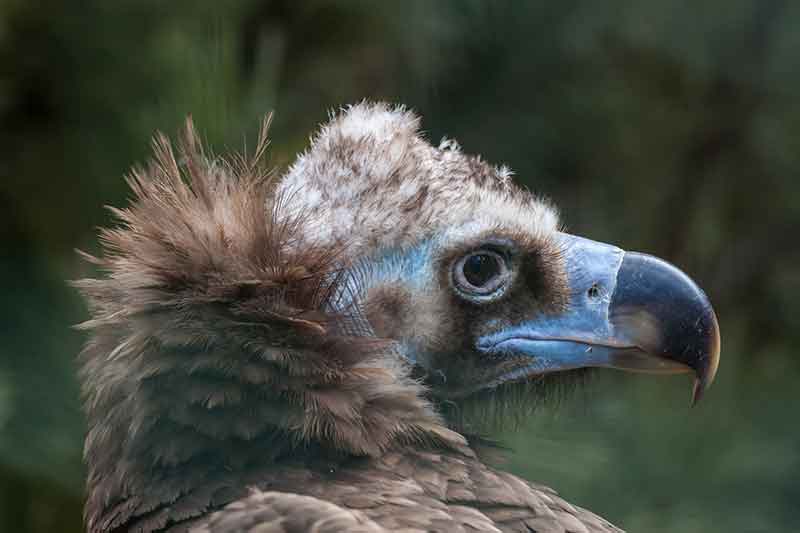
The cinereous vulture, also known as the Eurasian black vulture or the monk vulture, is one of the world’s largest vultures with a wingspan that measures almost 3 m. It has mostly dark brown feathers with a grey head, neck, and bill.
Like all vultures, the cinerous vulture eats mostly carrion ranging from large mammals to fish and reptiles. It has also been known to take live prey including domestic animals such as cattle, piglets, lambs, and puppies.
Its population is in decline due to poisoning, a reduction in the availability of food, and the loss of habitat.
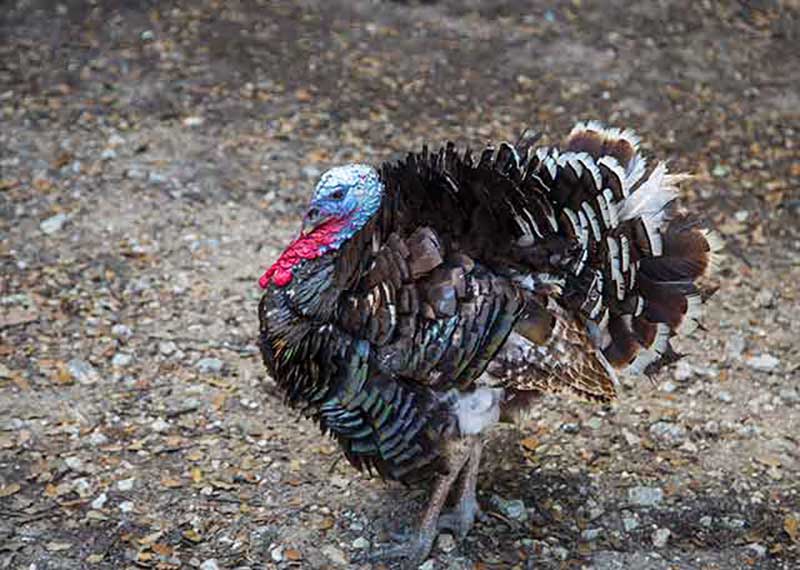
The wild turkey is the heaviest member of the Galliformes, an order of ground-feeding birds that also includes chickens, peafowl, and pheasants, and the ancestor of the domestic turkey.
It is dark brown or grey brown overall with a bronze sheen to its feathers. Males, called toms or gobblers, have a large, featherless blue head, with red wattles on the throat and neck, and fleshy growths called caruncles on the head which become engorged when the turkey is excited. They have large fan-shaped tails tipped with white, and dark wings with white bars.
There were attempts to introduce the wild turkey to Britain in the 18th century but these were not successful, mainly because local poachers found it easy to shoot them.

The Andean condor is the largest flying bird in the world by weight and wingspan. It is a large black vulture with a ruff of white feathers at the base of the neck and large white patches on the wings.
They are found in the Andes mountains and surrounding Pacific coasts of western South America and tend to favour windy areas where they can glide on air currents with little effort.
Andean condors are long-lived birds, surviving to over 75 years in captivity and up to 50 years in the wild. They do not begin breeding until they are 5 or 6 years old and only produce a single chick every other year which must be cared for by both parents for a full year.

The Muscovy duck is a large, heavy-bodied duck found in the Americas. It was domesticated by Native Americans and was brought to Europe on Christopher Columbus’s ship the Santa Maria in the 16th century. It is usually known as a Barbary duck in culinary settings.
True wild Muscovy ducks have dark plumage with a green gloss and white patches on the wings. On the face are red caruncles and black skin patches. Caruncles may also form if the skin is irritated. Female Muscovy ducks sometimes have caruncles on the back of their heads where drakes have grabbed them during mating.
Domestic Muscovy ducks have variable plumage that ranges from dark brown, to black and white, to all white. The caruncles on the face are a much brighter red and more pronounced.

The marabou stork is a large wading bird that breeds in sub-Saharan Africa. It reaches heights of 1.5 metres and has a wingspan of up to 3.7 metres has been recorded which is the largest of any living bird.
It has a black back and white underparts, a bare head and neck, and a tuft of what looks like hair on its head. The bill is massive with a pink gular sac on its throat and it has skinny white legs. It is nicknamed the ‘undertaker bird’ due to its appearance when seen from behind when it looks as though it is wearing a cloak.
Marabou storks expend very little energy and spend most of the time standing around. It is an opportunistic feeder, eating mainly carrion and faeces, but will take any animal matter it can find including other bird chicks including pigeons, doves, pelicans, and even flamingos. To cool down it poos down its legs which give them their white appearance.

The Sri Lanka frogmouth, also known as the Ceylon frogmouth, is found in Western Ghats of south India and Sri Lanka. It is highly camouflaged that helps it blend in with dried leaves; males are grey-brown with fine bars and spots on the crown, while females are chestnut brown with fewer markings.
Like all frogmouths, the species has a large head with a wide, hooked bill and slit-like nostrils. Its small eyes face forward which gives it a wide field of binocular vision, and they are surrounded by short, stiff bristles.
Each Sri Lanka frogmouth has a favourite perch where it spends most of the day and will only move on if it is disturbed.
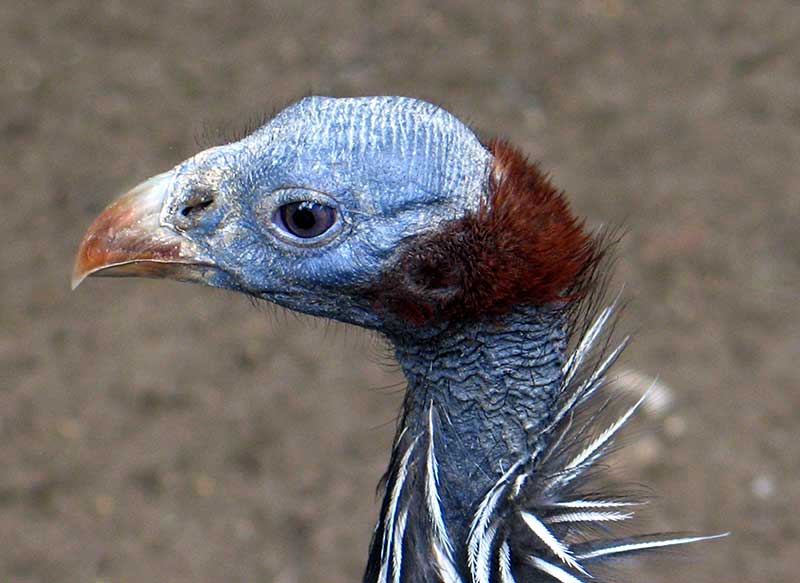
The vulturine guineafowl is the largest living species of guineafowl measuring up to 70 cm in length and weighing up to 1.6 kg. Although it is sometimes known as the ‘royal guineafowl’, its more common name is due to its bald head and long bare neck which resemble that of a vulture. On top of the head is a horny helmet and there are tiny brown feathers on the back of the nape, below which is a cape of glossy blue and white hackles.
Vulturine guineafowls are found in dry, open grasslands and savannahs in northeast Africa from southern Ethiopia to northern Tanzania.

The greater adjutant is a member of the stork family, and amongst the largest of all living storks measuring up to 150 cm tall and with an average wingspan of 250 cm. It has a bare red or yellow-skinned neck and head with a white collar ruff at the bottom, a massive wedge-shaped bill, and an inflatable pouch below its neck which turns bright orange in breeding season.
The Moghul emperor, Babur, recorded a myth about the greater adjutant in which a snakestone existed in the skull of the bird which was an antidote for snake venom and poison. The stone was meant to be very rare as it could only be retrieved by a hunter who could kill the bird without letting its bill touch the ground, otherwise the stone would evaporate. In India, practitioners of folk-medicine believed that chewing a piece of the stork’s flesh with betel could cure leprosy.
There are just 3 breeding populations of greater adjutants – two are found in India, and one is in Cambodia – but they disperse more widely after breeding season.
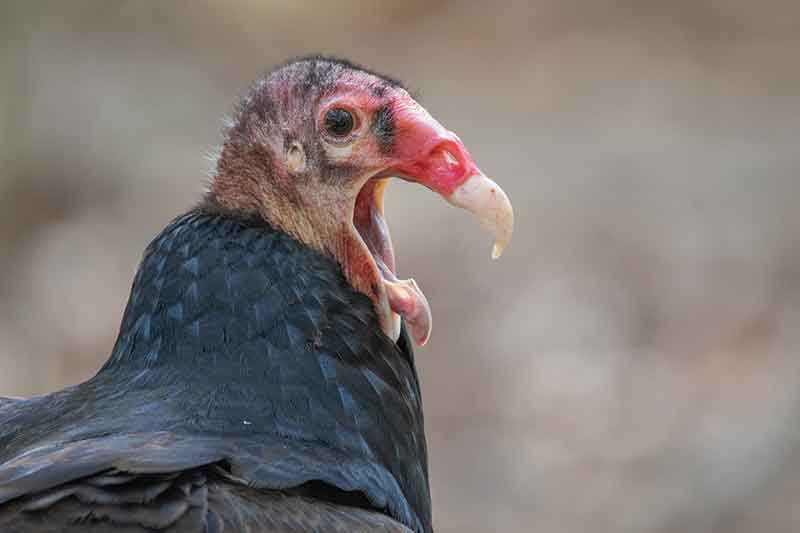
The turkey vulture, also known as the turkey buzzard, is a New World vulture and the most widely distributed in the Americas. Its common name relates to its bald red head and dark brown plumage which is similar to that of the male wild turkey. It is a big bird, measuring up to 80 cm in length and weighing up to 2.5 kg, and with a wingspan of up to 180 cm.
It has few predators, and its primary form of defence is to regurgitate semi-digested meat, the smell of which is usually enough to deter any creature that gets to close. The substance will also sting if the predator gets too close. If it needs to take flight to flee from a predator, the turkey vulture will sometimes vomit any undigested food from its crop.
Like other vultures, the turkey vulture keeps cool by defecating on its legs, a habit called urohidrosis.
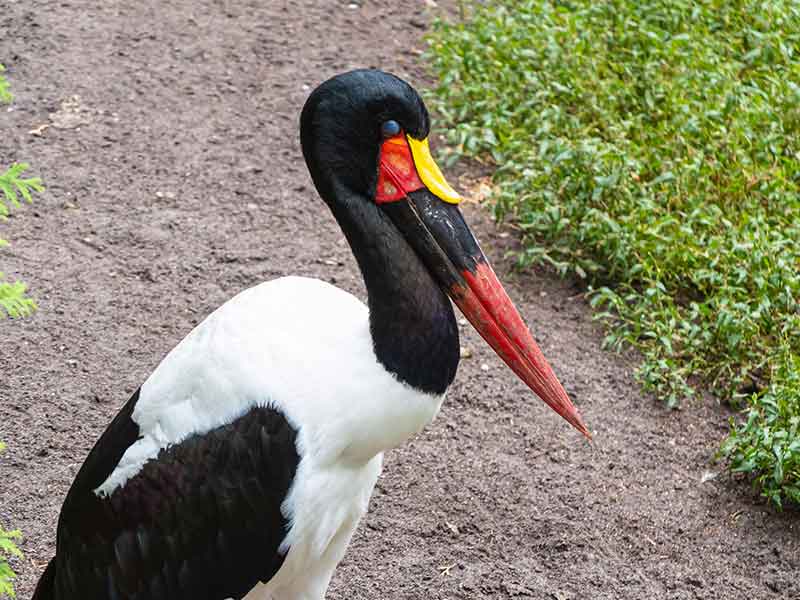
The saddle-billed stork is a large, wading bird found in sub-Saharan Africa, and a close relative of the black-necked stork. It reaches heights of 150 cm and has a wing span of up to 270 cm, and the male, which is larger and heavier than the female, can weigh up to 7.5 kg. It has iridescent black and white plumage with a bare red patch on its chest. The bill, which measures about 35 cm in length, is red with a black band. On the upper side is a yellow frontal shield with small wattles that hang below which look a little like stirrups, and gives the species its name.
In Egyptian hieroglyphics, the saddle-backed stork is represented with the phonetic value “bꜣ”. Early depictions of the bird from the Late Predynastic Period are very accurate but from the 3rd Dynasty, the bill of the stork began to shorten. Later, as the species disappeared from Egypt, the glyph transformed some more with a shorter neck and the incorrect placement of the wattles on the neck rather than at the base of the bill.
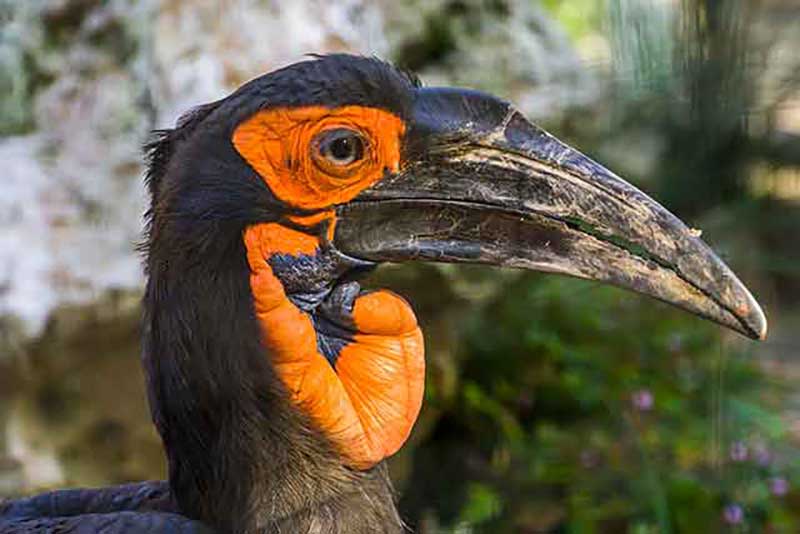
The southern ground hornbill is one of only two species of ground hornbill, the other being the Abyssinian ground hornbill, and the largest species of hornbill in the world. It is a large bird measuring up to 1.3 m long. Males weigh up to 6.2 kg while females are slightly smaller weighing up to 4.6 kg. It has a wingspan that measures up to 1.8 m and can fly at almost 30 km/h. The male has jet black feathers except for white tips on the wings, yellow eyes, and patches of bare red skin on the face and throat. Females are similar but has a patch of violet blue on the throat. It is thought that the bare skin keeps dust out of the birds’ eyes when they forage during the dry season.
It is an important bird in many African cultures often associated with death, evil, and bad luck. During breeding season male hornbills inflate their wattles and make booming calls to attract females and these loud calls are said to forecast rain and end droughts.
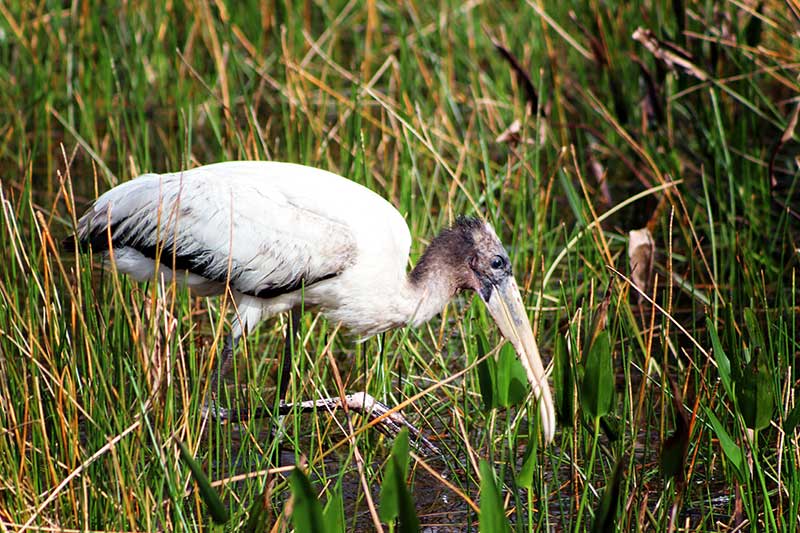
The wood stork is a large wading bird and the only member of the stork family to breed in North America. It measures up to 115 cm tall and has a wingspan of up to 180 cm with males weighing an average of 2.7 kg. It has mainly white plumage with black flight feathers and a black tail that has a green and purple iridescence. The head and neck are bare with dark grey scaley skin, and it has a long black bill that curves downwards towards the tip. The legs and feet are dark and in breeding season the toes are pink.
Despite its ungainly appearance, the wood stork is a good flier alternating between flapping its wings and soaring on thermals with its neck and legs outstretched. When perched it draws its neck into its body giving it a humpbacked look. They often feed in groups arranging themselves in lines and walking slowly through water with their heads down foraging for fish and insects.
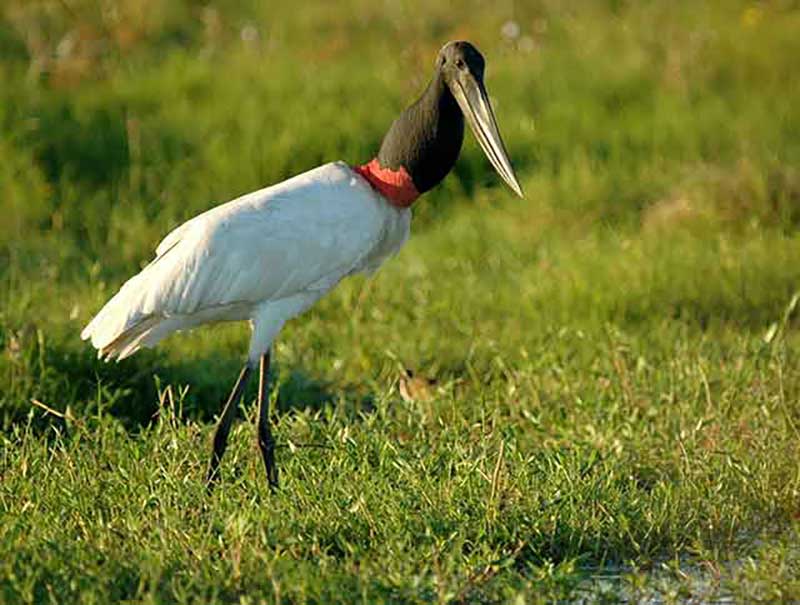
The jabiru is a very large stork found in the tropical lowlands of the Americas from Mexico to Argentina and the largest flying bird in South and Central America. It has occasionally been spotted in the United States, usually in Texas but sometimes as far north as Mississippi. Its name comes from a Tupi-Guarani word meaning “swollen neck”.
Jabirus exhibit high sexual dimorphism with males being about 25% larger than the females. An adult male jabiru can measure up to 153 cm tall with a 280 cm wingspan and weigh between 4.3 kg and 9 kg. It has white plumage overall with a bare black head and neck, and a massive, black upturned bill. At the base of the neck is a red inflatable pouch which helps with feeding and in males expands to the size of a football during courtship displays.
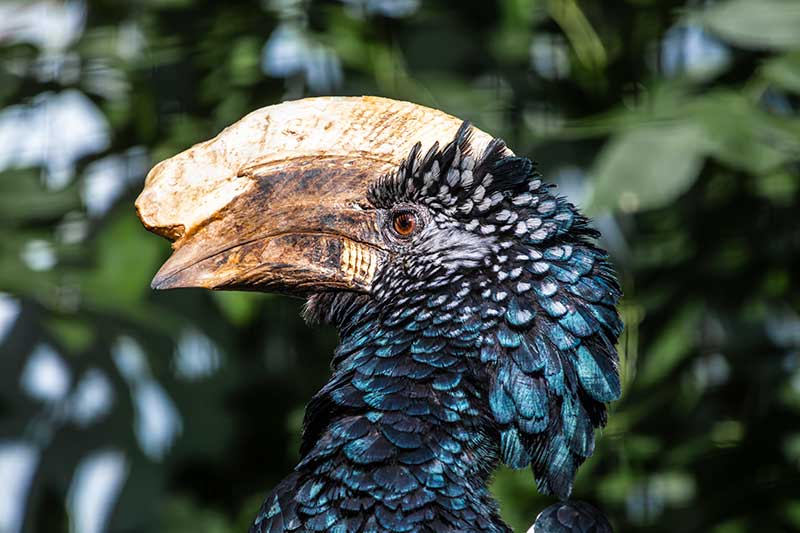
The silvery-cheeked hornbill is a large species of hornbill found in tall, evergreen forests of East Africa. It has iridescent black plumage with small, white patches under the wings, and on the back, rump, and edges of the tail. On the head the face is silver-grey and there is a large, creamy coloured casque on the top of the pale, downward-curved bill which is much larger in the males. The female has a circle of bare skin that surrounds the eye.
The purpose of the casque is to help support and add strength to the bill. It also helps augment the hornbill’s calls which are a series of loud honks and yaps given in quick succession. Because the casque may take many years to reach full size, it is thought they signal sexual maturity and help attract a mate too.
Silvery-cheeked hornbills eat mainly fruits, in particular figs. They will also eat lizards, centipedes, insects, spiders, and the chicks of other species of birds, usually by foraging amongst foliage, but sometimes in flight.

The Californian condor is a New World vulture and the largest flying bird in North America with a wingspan of up to 3 m. It has black plumage overall except for broad, white triangular-shaped patches on the underside of its wings. Like most vultures, it has very few feathers on its head and neck and the bare yellowy-orange skin flushes in response to an emotional state, which enables individuals to communicate with each other. The female condor is smaller than the male which is unusual for birds of prey.
In 1987, the California condor became extinct in the wild, but since then a successful captive breeding programme has seen numbers increase although they are still one of the world’s rarest birds. The project is one of the most expensive conversation efforts in history, costing the United States over $35 million with an annual maintenance cost of over $2 million.
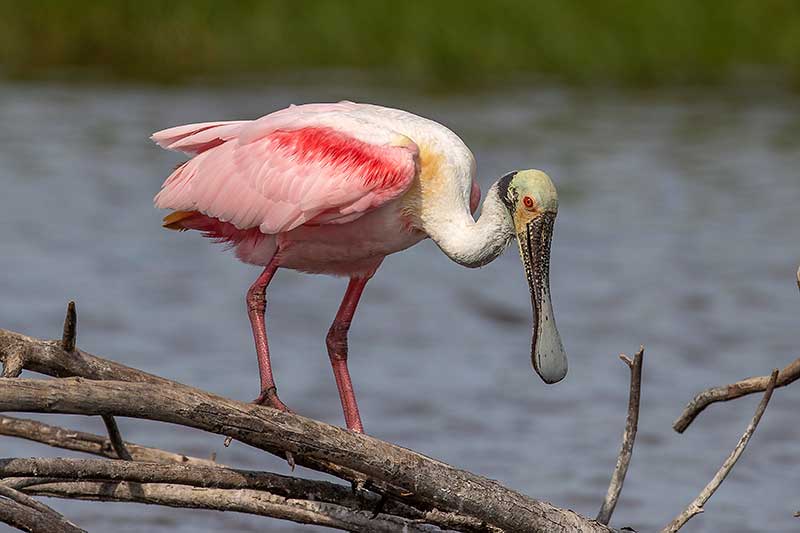
From a distance the roseate spoonbill looks like it might be a pretty bird. It has pale pink plumage with brighter pink shoulders and rump. However, the greenish head has no feathers, and the eyes are bright red, while the large grey bill is spoon-shaped. Like flamingos, roseate spoonbills get their pink colouration from pigments called carotenoids in the aquatic invertebrates they eat.
It is 1 of 6 species of spoonbill and the only one found in the Americas. It is found mostly in South America as well as the Caribbean, Central America, Mexico, and the Gulf Coast of the USA.
Roseate spoonbills forage in shallow fresh and saltwater swishing its bill from side to side to catch small fish, crustaceans, insects, and plant matter, often in mixed species groups with egrets and ibises. It holds its body horizontally when foraging which helps distinguish it from similar looking birds.
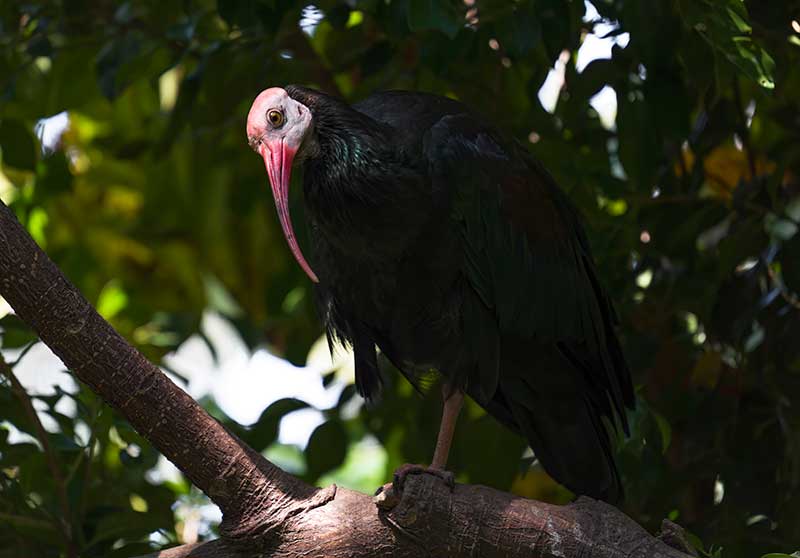
The southern bald ibis is a large bird endemic to the open grassland and semi-desert in the mountains of southern Africa. It measures about 75 cm In length with a 130 cm wingspan, and weighs around 1.2 kg
It has dark blue-black plumage with iridescent tones of green, violet, and bronze, and long blue-green feathers on its neck. The head is bare and covered with wrinkled, pale skin which gives rise to its scientific name Geronticus calvus, which comes from the Latin meaning bald, old man. On the top of the head, the dome-shaped crown is red, as is the long down-curved bill and legs.
Although, the southern bald ibis is listed as vulnerable on the ICUN Red List, with a total breeding population of just 4,600 birds, it is not immediately at risk of becoming extinct. Threats include disturbance at their breeding sites and habitat destruction, as well as hunting of chicks and eggs for food and medicine.
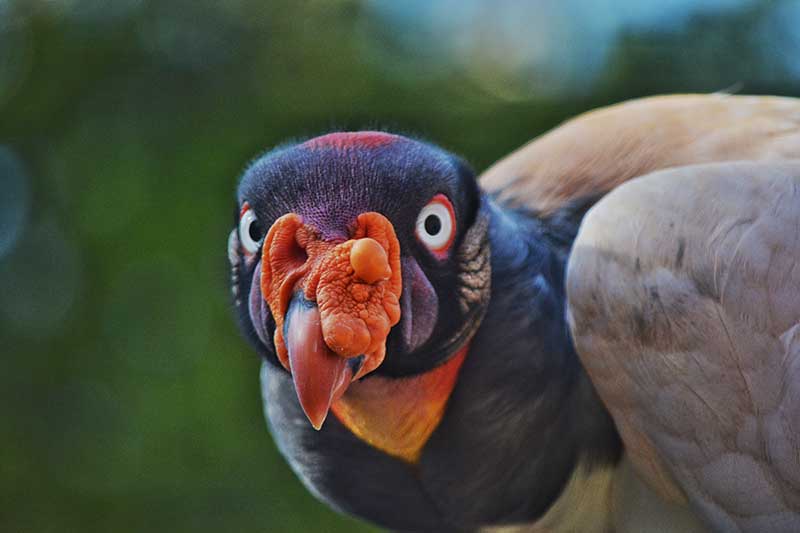
After the two species of condor, the king vulture is the largest of the New World vultures measuring 65 – 80 cm in length, with a wingspan of 1.2 – 2 m and weighing 2.5 – 4.5 kg.
It has white plumage on its body with a slight pinky-yellow tinge, and contrasting black wing coverts and flight feathers. The tail is dark grey as is the thick neck ruff. Like most species of vulture, its head and neck are bald with red and purple wrinkled skin on the head, bright orange on the neck, and yellow on the throat. On the cere there is a large orange caruncle which is fully formed by the time the king vulture is 4 years old. The eyes are white bordered with red, and it has no eyelashes.
Relative to its size it has the largest head and strongest bill of all the New World vultures, but despite this it is largely unaggressive. It has few predators; snakes prey on its eggs and chicks, while big cats such as jaguars sometimes hunt and kill adults when they are feeding from a carcass.
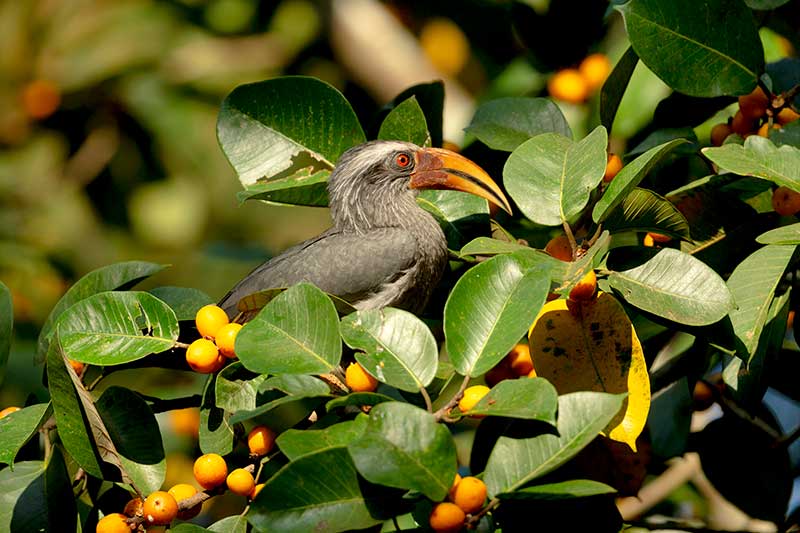
The Indian grey hornbill is a medium-sized, grey-brown bird with darker wings and a distinctive white-tipped tail. Its red eyes are framed by eyelashes and surrounded by grey skin. It has a yellow and black bill and a narrow, protruding casque, which is larger in males. Its call is a high-pitched squeal, similar to that of a kite, and its flight alternates between rapid wingbeats and short glides.
It is widespread across much of India as well as some neighbouring countries, including Pakistan, Nepal, and Bangladesh. Unlike other hornbills that prefer dense forests, the Indian grey hornbill thrives in dry plains, foothills, and open habitats. It is often seen in deciduous forests, orchards, thorny scrub jungles, as well as urban parks and gardens, where it mostly feeds on fruit, particularly figs.
It is almost completely arboreal, but occasionally descends to the ground to pick up fallen fruit or to dust bathe. It is a sociable species, often engaging in playful activities such as bill grappling and aerial jousting.

The Northern bald ibis is an Old World ibis with glossy black plumage that shimmers with bronze, green, and violet iridescence. Its bald head and throat are a dull red, as are its long, curved bill, legs, and feet. It has a distinctive wispy ruff of feathers at the back of its neck. Males and females are similar, but males are slightly larger with longer bills, a result of sexual selection.
Unlike other ibises, which are waders that nest in trees in wetlands, the Northern bald ibis nests on undisturbed cliff ledges, often in coastal regions or near rivers, and forages for food in grazed dry areas such as steppes and fallow fields.
Once widespread across the Middle East, northern Africa, and central and southern Europe, it is now critically endangered, with most of its population confined to Morocco.
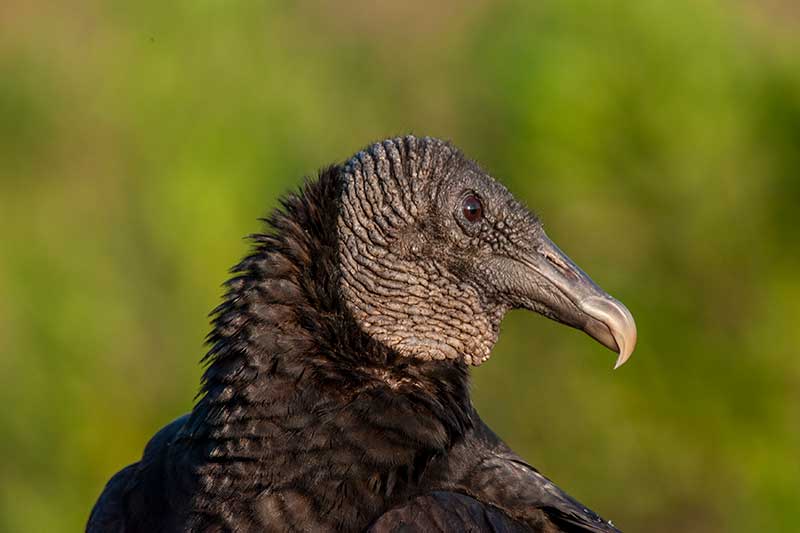
The black vulture, also called the American black vulture or Mexican vulture, is a small New World vulture with broad wings, a short tail, and a small head. Its plumage is entirely black, except for silvery-grey patches on the underside of its wings. Its bald head is greyish-black, and it has a short, hooked beak. Like other New World vultures, it lacks a voice box, limiting its sounds to raspy hisses and grunts.
It ranges across the mid and southern United States, Mexico, Central America, and much of South America, with its territory expanding northward in recent decades. The black vulture inhabits open areas with scattered scrub, as well as lowland forests, grasslands, wetlands, and swamps.
Unlike turkey vultures, black vultures have a relatively sense of smell. To find carrion, they rely on sight or follow turkey vultures, often chasing them away from carcasses to claim the food.
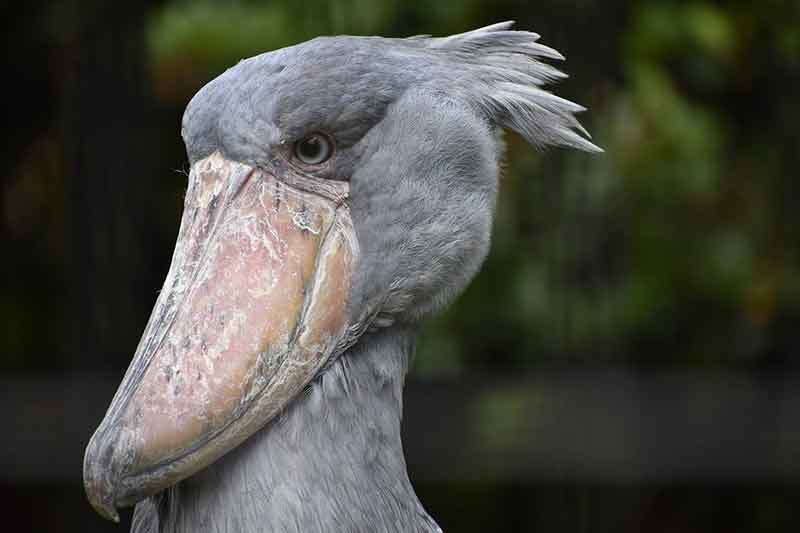
The shoebill, also known as the whale-headed stork, is a large, long-legged wading bird. It has blue-grey plumage with slate-grey flight feathers and elongated breast feathers. The most distinctive characteristic of the shoebill is its massive, clog-shaped bill, which is horn-coloured with grey markings and gives the bird its name.
Native to East Africa, the shoebill inhabits swamps and wetlands, favouring shallow water with dense vegetation. It is known for its patience, often standing motionless for hours while waiting for prey. Its bill is uniquely adapted for probing in muddy water without becoming stuck. It has sharp edges and a hooked tip to process prey, and its large gape allows the bird to swallow fish whole. The shoebill’s diet also includes snakes, baby crocodiles, and lizards.
Although once classified as a stork, the shoebill belongs to its own family. It shares traits with storks, such as long necks and legs, but is more closely related to pelicans and herons. Its closest living relative is the hamerkop.
16 Responses
what are birds that look like a vulture
they ugly af. looking like frank from shameless
LMAO
It’s intriguing that many of these are carrion eaters. A unique collection of fascinating birds!
very fine lads. Doing their best. Don’t need no aesthetics. 10/10 would pet the willing even after emerging from a not-so-fresh carcass and pooping on their own leggies and/or vomiting in my direction because I am a scary, no good egg thief.
there so ugly
Um no… They are so gorgeous and beautiful, also very unique.. So no
Can I just 100% agree with this?
i think they are fine creatures but very uggo sorry <3
They all look super cool and unique!
Thanks 🙂
they are ugly animals but we nead them to survive
Is the Buzzard want the ugliest birds?
Literally all birds are beautiful and wonderful and this list is just anti-bird propaganda, I’m very upset right now and I must speak up for these cute feathered friends whose incredible calls apparently haven’t reached this website’s editors
All of these birds are amazing beautiful and they deserve all the good and kindness in the world
Sincerely,
A reader with objectively correct opinions
Please fix your list at your earliest convenience
Bro you eat eggs